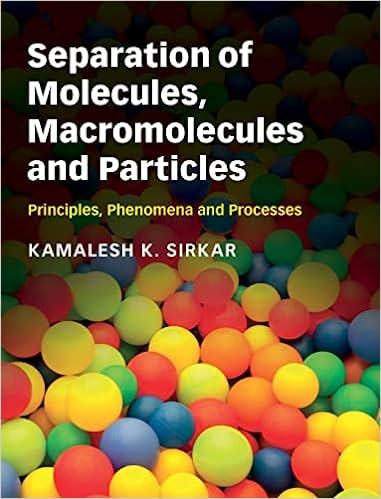Question
Use the Peng-Robinson EOS to calculate the fugacity coefficient of pure carbon dioxide, estimate the vapor pressure and saturated liquid and vapor molar volumes at
Use the Peng-Robinson EOS to calculate the fugacity coefficient of pure carbon dioxide, estimate the vapor pressure and saturated liquid and vapor molar volumes at temperatures of 10,20 and 30C. How do your predictions compare with the experimental data reported in the table below? Temperature C Pressure Bar Liquid Volume c 3/moIe Vapor Volume c 3/moIe 10 45.02 51.11 325.6 20 57.29 56.91 226.6 30 72.14 74.18 127.5 Strategy We want to calculate vapor pressure ofa liquid at a temperature. We did vapor liquid equilibrium for mixtures. Here we want to do VLE for a pure component. Hence, we should expect that the fugacity of the component (or fugacity coefficient) in liquid should be the same as its fugacity in vapor. In other words, @ V or In L = In V (1) G E = In p = Z 1 ln(Z Q) qI (2) RT b ps* ftT + # th (3) (4) (5) 1 ln Z*+ # (6) (7) The sequence of operations is as follows. 1. Look up the critical properties for CO2 you need to calculate all the constants. 2. Assume PSa*. 3. Calculate (Eqn. 3). 4. Calculate ZL (Eqn. 4). You may need to converge on ZL. 5. Calculate ZV (Eqn. 5). You may need to converge on ZV. 6. Calculate In V and In g L using Equation 2. Please make sure that when you are using the equation to calculate In V, make sure you use ZV. Similarly, to calculate In L, use corresponding Z. 7. Is g equal to g V? If not, assume a new PSat and repeat the procedure until you converge. Hint: If g is greater than L, would you increase or decrease the assumed value of PSat for the next cycle?
Step by Step Solution
There are 3 Steps involved in it
Step: 1

Get Instant Access to Expert-Tailored Solutions
See step-by-step solutions with expert insights and AI powered tools for academic success
Step: 2

Step: 3

Ace Your Homework with AI
Get the answers you need in no time with our AI-driven, step-by-step assistance
Get Started


